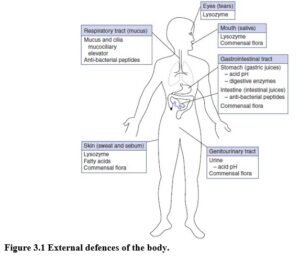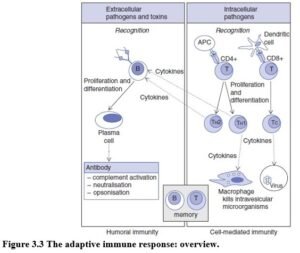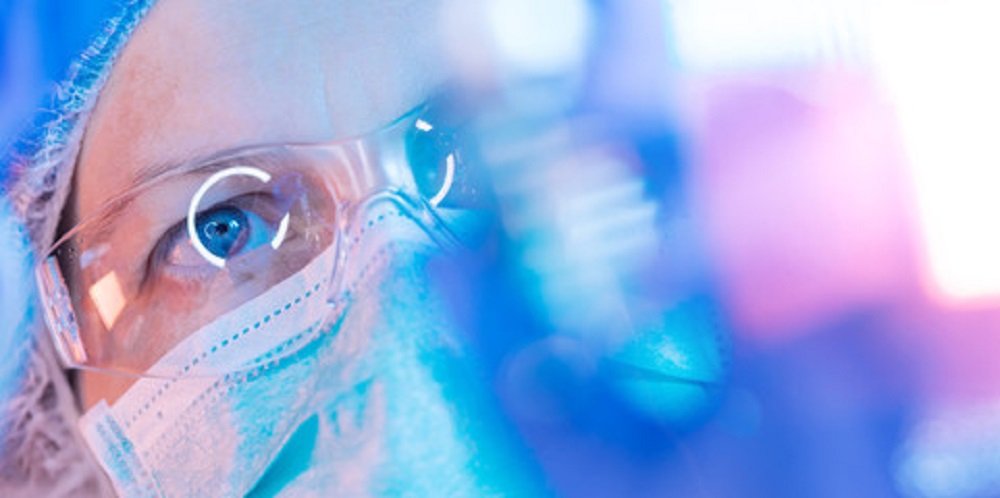Non-immunological external defences
♦Innate immunity
♦Adaptive immunity.
The principle difference between innate and adaptive immune responses is in pathogen recognition.
Many effector mechanisms used to kill pathogens are shared by both systems.
NON-IMMUNOLOGICAL EXTERNAL DEFENCES Skin and mucus membranes form physical barriers to infectious organisms. When breached (e.g. burn victims) infection is common despite normal immune function. Pathogens must attach to epithelial cells and migrate through the epithelium to establish infection. Surface epithelia provide mechanical, chemical and microbiological barriers as a first line of defence against infection (Figure 3.1).

Mechanical barriers prevent microbial attachment and include
♦Flow of secretions across epithelium – when flow is obstructed infection is common
♦Mucociliary elevator. Inhaled organisms are trapped by mucus, which is moved by the coordinated action of cilia on the surface of ciliated epithelium. In the respiratory tract, mucus and organisms are moved to the oropharynx and swallowed or expectorated.
Chemical barriers Chemical barriers include the acid environment in the stomach, together with digestive enzymes and the antimicrobial effect of lysozyme found in tears and sweat, as well as defensins (bactericidal peptides found in the respiratory and gastrointestinal tracts).
Microbial barrier Commensal flora, found on skin and mucosal membranes, form a microbial barrier by competing for nutrients and attachment sites on cells. Some also produce anti-bacterial substances.
INNATE IMMUNE RESPONSES When microorganisms penetrate epithelial surfaces they are usually killed by the innate immune response (Figure 3.2). Innate immunity acts immediately, recognises broad microbial patterns rather than unique specificities and does not produce immunological memory.
Macrophages and neutrophils have surface receptors that recognise and bind common constituents of many bacteria. Binding induces engulfment, killing and degradation of bacteria – termed phagocytosis.

Following phagocytosis, activated macrophages secrete chemical messengers (cytokines), which initiate inflammation. Inflammation increases blood vessel permeability, rapidly increasing delivery of cells and proteins of the immune system to the infected area. Activation of complement, a system of plasma proteins, generates fragments that coat or opsonise bacteria increasing the efficiency of phagocytes. Complement also lyses some bacteria, and releases small pro-inflammatory peptides.
Macrophage activation results in cytokine release, causing a rise in body temperature and an acute phase response. Acute phase proteins are produced in the liver and contribute to inflammation and host defence.
NK cells recognise and kill virus-infected cells. NK cells are activated by cytokines (TNF-α. and IL-
12) produced by macrophages. Virus infected cells produce interferon-α and β (IFN-α. and β), which inhibit viral replication within cells, make surrounding cells more resistant to viral entry, and also activate NK cells.
The innate immune response makes a crucial contribution to activation of adaptive immunity
♦Macrophages enhance the adaptive immune response by acting as antigen presenting cells (APCs).
♦Cytokines produced by cells (macrophages and NK cells) of innate immunity enhance responses by the adaptive immune response.
♦The inflammatory response increases the flow of lymph containing antigen and APCs to the lymphoid tissue.
ADAPTIVE IMMUNE RESPONSES Adaptive immunity provides protection when innate immunity fails to eliminate infection. Adaptive immunity develops slowly, has unique specificity for antigen and produces immunological memory (Figure 3.3).
Adaptive immunity results in selection of lymphocyte clones bearing highly antigen-specific receptors (recognition molecules). Each lymphocyte expresses cell-surface receptors of a single specificity. B cell receptors (immunoglobulins) bind extracellular molecules and pathogens, while T cell receptors (TCR) bind peptide fragments bound to MHC molecules on cell surfaces.

Following initiation of an immune response, the antigen-specific lymphocyte(s) proliferate and its progeny differentiate into effector cells that can eliminate the pathogen. A subset of these proliferating lymphocytes differentiates into memory cells capable of responding rapidly if the same pathogen is encountered again.
Adaptive immunity can be divided into humoral (antibody-mediated) immunity, and cell-mediated immunity. Both types of immune response require activation of helper T cells (TH), a pivotal lymphocyte subset that are essential for the development of effective adaptive immune responses (Table 3.1).




